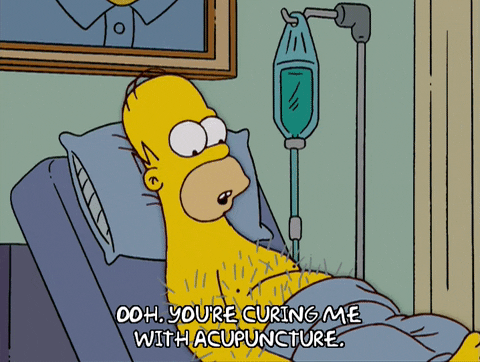Now that we’ve talked about what endometriosis is and how it is difficult to diagnose, let’s discuss what to do if you are diagnosed with or strongly suspect that you may have this condition. I’ve listened to nearly a dozen podcasts, read books, read research, and have experimented with several different things. I don’t call myself an absolute authority, but I can give testimony as to what has helped me. I’m going to first talk about providers that can help, diet/nutrition, hormone regulation/surgeries, and movement/exercise. I think it’s also important to critically look at expectations in all scenarios.
Those with endometriosis tend to have painful and irregular cycles. When I was about 29 years old I met an acupuncturist for the first time. We were networking in the same small business group meeting and he invited me to come try it. I had no idea what to expect or ask for during my first mini-session, so I believe I asked him if he could help with some constipation issue. I fell asleep during the treatment, so it was obviously awesome. After taking the needles out, we were chatting and it hit me: I had to GO!! Dashed to the bathroom and I won’t discuss beyond that point. Naturally, I returned to see him and asked if he could do anything for my very long, very painful and highly irregular period. Within two sessions I went from having an inconsistent menstrual cycle to one that would come every 23 days, last 4 days with minimal pain and cramping. I had lived with this for 13 years and it only took TWO SESSIONS?! I have periodic sessions with him to help maintain my menstrual cycle as well as other ailments and over time, my cycle has regulated itself to a 26 day cycle. It has not cured my endometriosis, that is not possible. However, he has helped maintain some sanity and has lessened my pain. I know when I can expect to get my period and I know how I can expect to manage my other symptoms around that time. To say that I recommend acupuncture is an understatement.

Another modality that works well for me is visceral manipulation. I practice it as a Physical Therapist for this reason. Because of all the scar tissue and subsequent inflammation as the endometrial tissue sheds, there tends to be swelling and, therefore, bloating. When I do the visceral manipulation on myself or have it done to me, it stimulates my lymphatic drive and the swelling/bloating starts to go down. As a result, I urinate A LOT after treatment. The kidneys reabsorb the extra fluid and brings it down to the bladder for you to excrete it that way. The increased lymphatic drive may also help with bowel movement and constipation. Again, it just depends on where your endometrium deposits are. The visceral manipulation also helps to make me feel less tight in my hips and abdomen. I have longer strides and my legs don’t feel as heavy. I feel lighter and my clothes fit better. It’s like taking a diuretic for people who are in a state of near-constant inflammation. This does will not get rid of scar tissue or endometrial deposits. If you’ve read my previous blog about fascia and the benefits of manual therapy, there is also the benefit of reestablishing the gut-brain connection. Visceral manipulation helps nearly all of my patients, but especially those with endometriosis, PCOS, and IBS.
Diet and nutrition is a very large and heavily debated factor in endometriosis management. A lot of people have decided to go vegan to cut out potential sources of estrogen and added hormones that are given to animals to help reproduce. There are other foods such as soy that have been shown to be high in estrogen, but I haven’t seen enough evidence to show that a full elimination is warranted because you would have to eat soy products in high quantities to achieve that kind of estrogen effect. I can not maintain a fully plant-based diet. It takes a lot of planning and I aim for at least one meal a day that is plant-based. Jessica Murnane has a website, cookbook and podcast that focuses heavily on her endometriosis journey. I enjoy the cookbook and utilize several of her recipes and advice. The podcast covers a wide variety of topics and other useful management tools. Here in Washington state, my patients have access to CBD and THC, which might be beneficial in helping with inflammation and general anxiety management. It might be beneficial to do an elimination diet and gradually add certain “triggering” foods back in to see if that is adding to your gut inflammation. Again, this does not take away the endometrial deposits that reacting monthly if you choose to have a period.
Hormone regulation is another way that people choose to help their endometriosis symptoms. It seems logical: take these birth control pills or insert this IUD and you won’t have a period! I choose not to be on hormonal birth control because it makes me a little crazy and if I decide to have children within the next few years, I don’t want to hamper the process by my body reacting to coming off hormone regulating pills on top of fertility issues. There is a condition related to this called Post-Birth Control Syndrome, where the body has trouble balancing its hormones after being under such strict regulation for a long time. I encourage my patients to do whatever they need to for their lives and families, and that includes birth control most of the time. Birth control has given us choice and personal freedoms that generations of women never had before. I only wish there was less hormone disruption involvement. Even if one chooses to go on hormone birth control, it does not take away the endometrial deposits that are already there and the associated scar tissue. It is the same with having the uterus removed or a full hysterectomy with the removal of the ovaries and fallopian tubes (I hate that word, but there doesn’t seem to be another word for the procedure in 2020!), if the endometrial deposits are elsewhere in the body then you still have the associated scar tissue. Not having the ovaries there will result in a halt of menstruation, and the endometrial deposits will stop reacting to the hormone cycle and will not shed. Hysterectomies have also been shown to significantly increase the risk of prolapse of the bladder and/or rectum that causes incontinence and may require surgical intervention. Endometrial ablation is another surgical procedure to remove the lining of the uterus, which will likely cease menstruation and will not allow for a viable pregnancy. It has been fairly successful in helping with menstrual pain, according to various studies.
Movement is important for fascia, gut motility, and even the regulation of our hormones. It helps keep insulin levels steady (along with proper nutrition) and improve lymphatic drainage. If you sit at your desk all day and don’t move much, the gut loses motility, fascia and muscles tighten, and the lymph that is already accumulating and being stagnant in your pelvic cavity increases. I try to get a lot of walking in weekly, perform a routine that has a lot of yoga poses to stretch fascia and improve weight bearing strength. Over-exercising can lead to amenorrhea due to extreme fat loss as fat cells help produce (in a small amount) and regulate estrogen.

I hope your takeaway message is that there are options for you if you do have endometriosis. Some are more extreme but it mostly requires you to be aware of some sort of management protocol with diet, movement, and your choice of therapy. As much as I hate being a Negative Nancy, it’s important to have expectations that match reality. Surgery is usually a choice for those who are diagnosed at Stage 4. For those who do not want surgery, I hope I have described some management treatments and tools. As always, I look forward to your questions or concerns.

Comentários